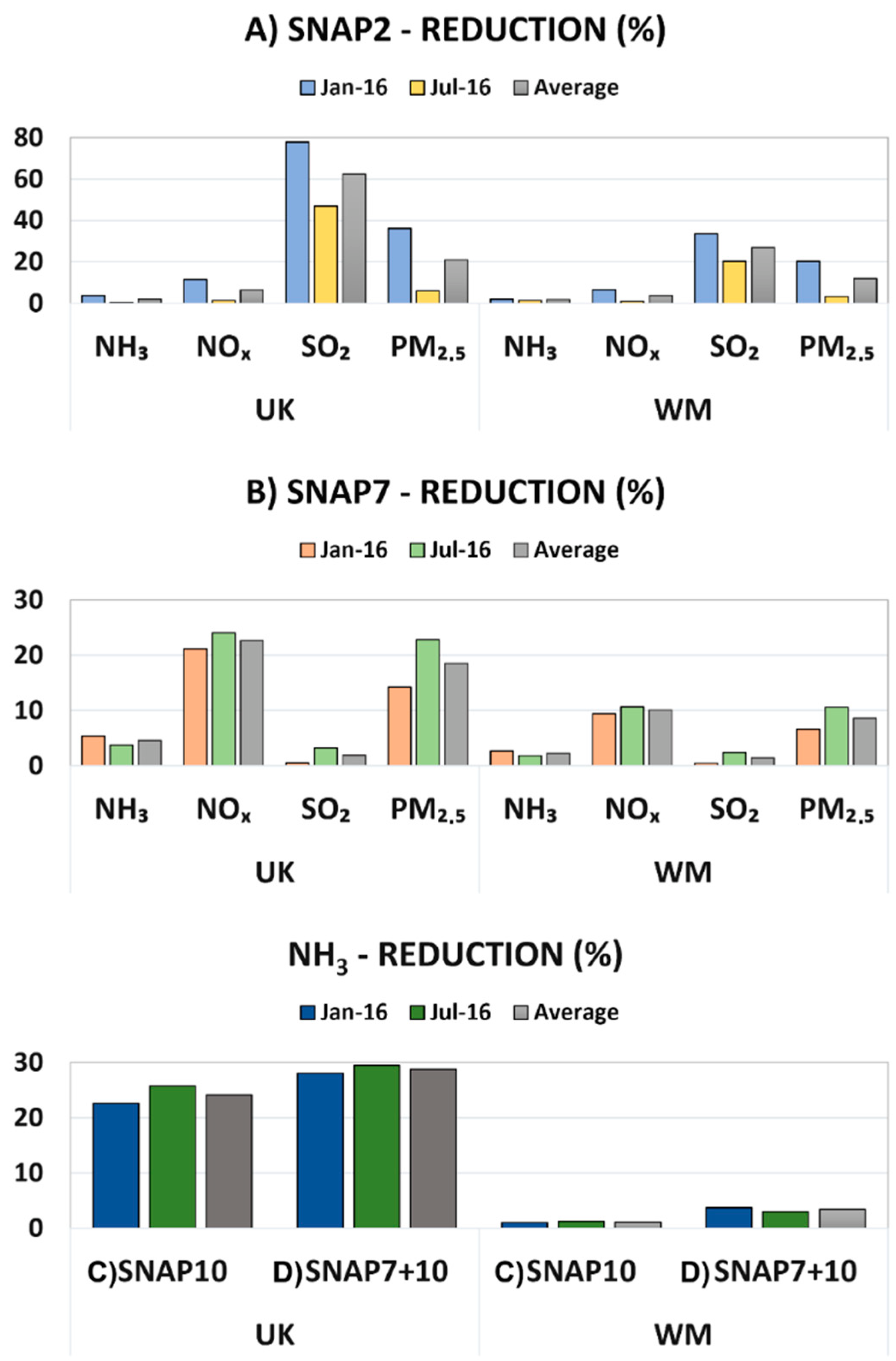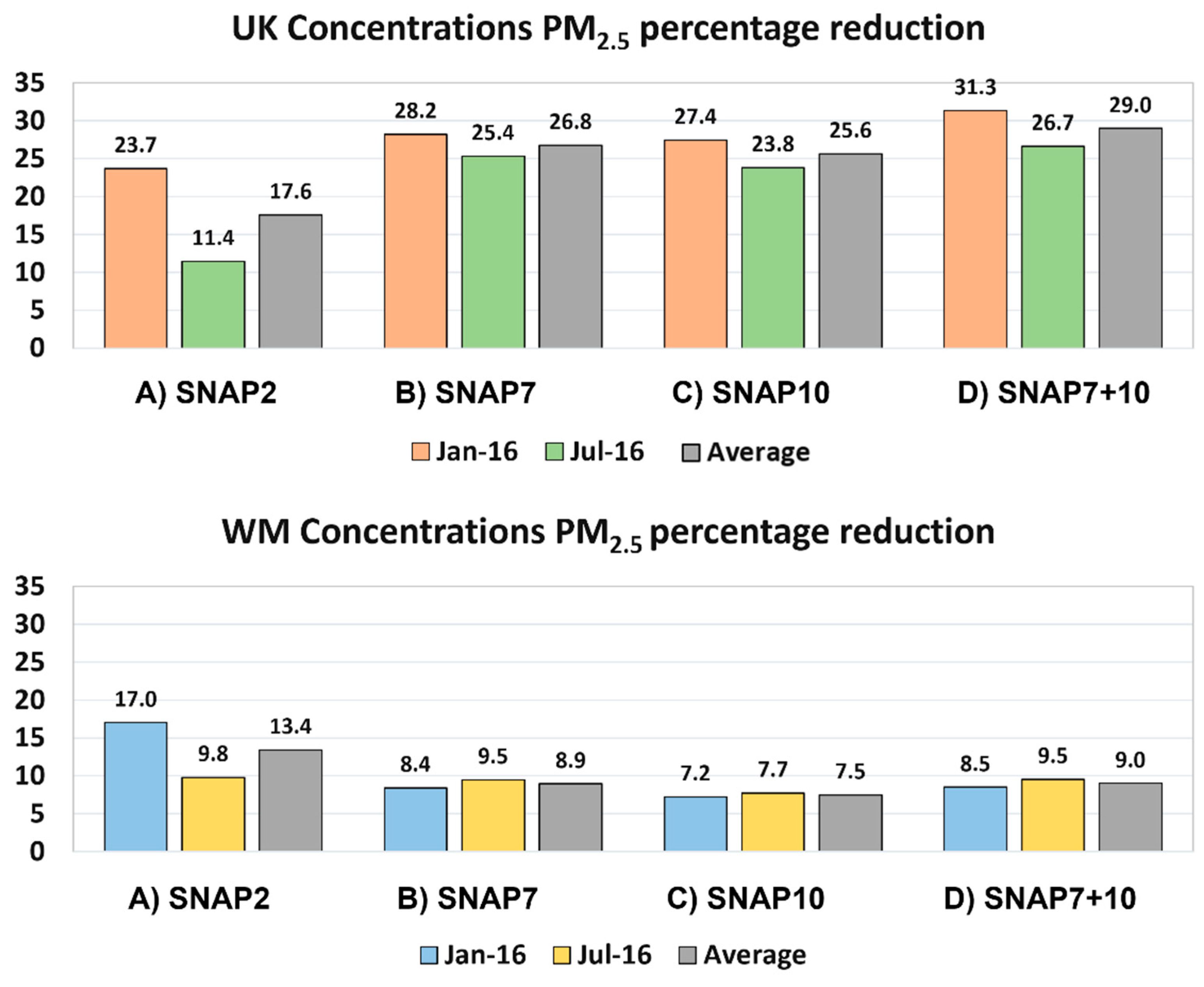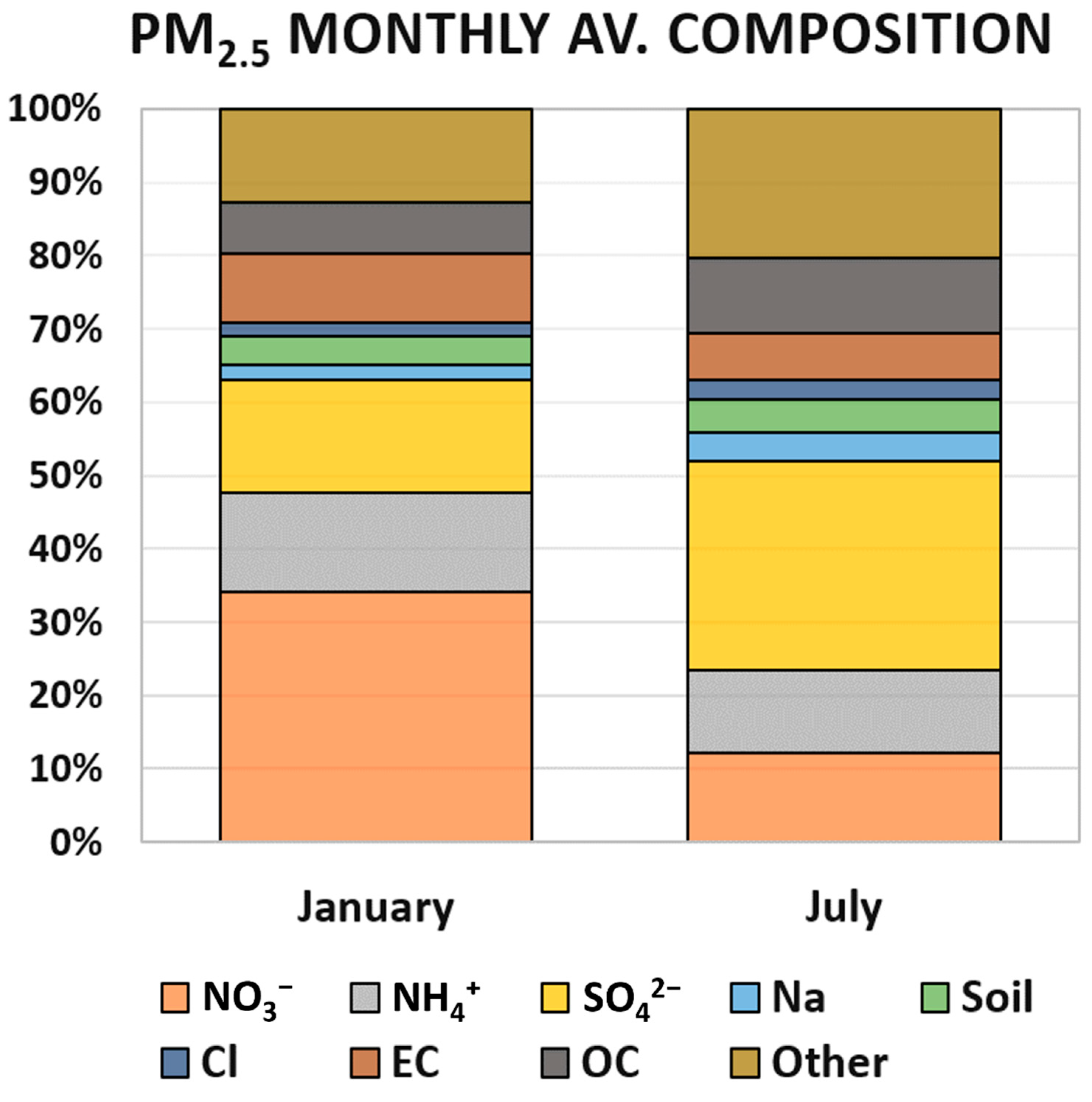Modelling the Impact of National vs. Local Emission Reduction on PM2.5 in the West Midlands, UK Using WRF-CMAQ
Abstract
:1. Introduction
2. Materials and Methods
2.1. Modelling System
| WRF Configuration | CMAQ Configuration | ||
|---|---|---|---|
| WRF version | 3.9.1 | CMAQ version | 5.2.1 |
| IC/BC | ECMWF ERA5 | Sp. Projection | Lambert Conformal Conic |
| Land use | USGS | IC/BC | CMAQ Hemispheric Outputs |
| Urban Physics | BEP | Chemical Scheme | CB05e51_ae6_aq |
| Boundary Layer | BouLac | Anth. Emissions | CAMS3.1/NAEI |
| Surface Layer | Monin | Temp. Profiles | Simpson et al., 2012 [28] |
| Land surface | NOAH | Natural Emis. | MEGAN3.1 |
| Vertical Levels | 30 | Vertical Levels | 30 |
2.2. Simulation Period and Observation Sites
2.3. Scenario Design
3. Results
3.1. Modelling System Validation
3.2. PM2.5 Changes for Each Scenario
3.3. Scenario Effects on PM2.5 Components
4. Conclusions
Author Contributions
Funding
Institutional Review Board Statement
Informed Consent Statement
Data Availability Statement
Acknowledgments
Conflicts of Interest
References
- DEFRA. Air Quality Statistics—An Annual Update on Concentrations of Major Air Pollutants in the UK. Available online: https://www.gov.uk/government/statistics/air-quality-statistics (accessed on 5 October 2021).
- WHO. WHO Global Air Quality Guidelines: Particulate Matter (PM2.5 and PM10), Ozone, Nitrogen Dioxide, Sulfur Dioxide and Carbon Monoxide. Available online: https://apps.who.int/iris/handle/10665/345329 (accessed on 10 November 2021).
- Gov.UK. Trend Deck 2021: Urbanisation. Available online: https://www.gov.uk/government/publications/trend-deck-2021-urbanisation/trend-deck-2021-urbanisation (accessed on 5 October 2021).
- NAEI. National Atmospheric Emission Inventory for UK. Available online: https://naei.beis.gov.uk/ (accessed on 20 May 2021).
- DEFRA. Clean Air Strategy. Available online: https://www.gov.uk/government/publications/clean-air-strategy-2019 (accessed on 6 October 2021).
- Gov.UK. Emissions of Air Pollutants in the UK—Particulate Matter (PM10 and PM2.5). Available online: https://www.gov.uk/government/statistics/emissions-of-air-pollutants/emissions-of-air-pollutants-in-the-uk-particulate-matter-pm10-and-pm25 (accessed on 12 December 2021).
- Gov.UK. Emissions of Air Pollutants in the UK—Ammonia (NH3). Available online: https://www.gov.uk/government/statistics/emissions-of-air-pollutants/emissions-of-air-pollutants-in-the-uk-ammonia-nh3 (accessed on 14 December 2021).
- AQEG. Fine Particulate Matter (PM2.5) in the United Kingdom. Available online: https://uk-air.defra.gov.uk/assets/documents/reports/cat11/1212141150_AQEG_Fine_Particulate_Matter_in_the_UK.pdf (accessed on 23 November 2021).
- Yin, J.; Harrison, R.M.; Chen, Q.; Rutter, A.; Schauer, J.J. Source apportionment of fine particles at urban background and rural sites in the UK atmosphere. Atmos. Environ. 2010, 44, 841–851. [Google Scholar] [CrossRef]
- Vieno, M.; Heal, M.R.; Twigg, M.M.; MacKenzie, I.A.; Braban, C.F.; Lingard, J.J.N.; Ritchie, S.; Beck, R.C.; Móring, A.; Ots, R.; et al. The UK particulate matter air pollution episode of March–April 2014: More than Saharan dust. Environ. Res. Lett. 2016, 11. [Google Scholar] [CrossRef]
- Vieno, M.; Heal, M.; Hallsworth, S.; Famulari, D.; Doherty, R.; Dore, A.; Tang, Y.; Braban, C.; Leaver, D.; Sutton, M. The role of long-range transport and domestic emissions in determining atmospheric secondary inorganic particle concentrations across the UK. Atmos. Chem. Phys. Discuss. 2013, 13, 33433–33462. [Google Scholar] [CrossRef] [Green Version]
- Vieno, M.; Heal, M.R.; Williams, M.L.; Carnell, E.J.; Nemitz, E.; Stedman, J.R.; Reis, S. The sensitivities of emissions reductions for the mitigation of UK PM2.5. Atmos. Chem. Phys. 2016, 16, 265–276. [Google Scholar] [CrossRef] [Green Version]
- Chemel, C.; Fisher, B.E.A.; Kong, X.; Francis, X.V.; Sokhi, R.S.; Good, N.; Collins, W.J.; Folberth, G.A. Application of chemical transport model CMAQ to policy decisions regarding PM2.5 in the UK. Atmos. Environ. 2014, 82, 410–417. [Google Scholar] [CrossRef] [Green Version]
- Carnell, E.; Vieno, M.; Vardoulakis, S.; Beck, R.; Heaviside, C.; Tomlinson, S.; Dragosits, U.; Heal, M.R.; Reis, S. Modelling public health improvements as a result of air pollution control policies in the UK over four decades—1970 to 2010. Environ. Res. Lett. 2019, 14. [Google Scholar] [CrossRef]
- Chalabi, Z.; Milojevic, A.; Doherty, R.M.; Stevenson, D.S.; MacKenzie, I.A.; Milner, J.; Vieno, M.; Williams, M.; Wilkinson, P. Applying air pollution modelling within a multi-criteria decision analysis framework to evaluate UK air quality policies. Atmos. Environ. 2017, 167, 466–475. [Google Scholar] [CrossRef]
- Sokhi, R.S.; San José, R.; Kitwiroon, N.; Fragkou, E.; Pérez, J.L.; Middleton, D.R. Prediction of ozone levels in London using the MM5–CMAQ modelling system. Environ. Model. Softw. 2006, 21, 566–576. [Google Scholar] [CrossRef]
- Beevers, S.D.; Kitwiroon, N.; Williams, M.L.; Carslaw, D.C. One way coupling of CMAQ and a road source dispersion model for fine scale air pollution predictions. Atmos Environ. 2012, 59, 47–58. [Google Scholar] [CrossRef] [PubMed]
- Skamarock, W.C.; Klemp, J.B.; Dudhia, J.; Gill, D.O.; Barker, D.M.; Wang, W.; Powers, J.G. A Description of the Advanced Research WRF Version 3; NCAR Technical note-475+ STR; National Center for Atmospheric Research: Boulder, CO, USA, 2008. [Google Scholar]
- Byun, D.; Schere, K. Review of the Governing Equations, Computational Algorithms and Other Components of the Models-3 Community Multiscale Air Quality (CMAQ) Modeling System. Appl. Mech. Rev. 2006, 59, 1–77. [Google Scholar] [CrossRef]
- Fraser, A.M.T.; Abbot, J.; Venfield, H.; Beevers, S.; Kitwiroon, N.; Beddows, A.; Carslaw, D.; Good, N.; Chemel, C.; Xavier, F.; et al. CMAQ-UK Development Phase 1 Summary Report Final; AEA/ENV/R/3334; 23/10/2012; Department for Environment Food & Rural Affairs (DEFRA): London, UK, 2012. [Google Scholar]
- Fraser, A.M.; Beevers, S.; Kitwiroon, N.; Xavier, F.; Sokhi, R.; Derwent, R. CMAQ-UK Development Phase 2 Report Final; Department for Environment Food & Rural Affairs (DEFRA): London, UK, 2014. [Google Scholar]
- Malardel, S.; Wedi, N.; Deconinck, W.; Diamantakis, M.; Kuhnlein, C.; Mozdzynski, G.; Hamrud, M.; Smolarkiewicz, P. ERA5 Reanalysis—European Centre for Medium-Range Weather Forecasts. 2017, updated monthly. ERA5 Reanalysis. Research Data Archive at the National Center for Atmospheric Research, Computational and Information Systems Laboratory. NCAR-UCAR, Ed. 2017. Available online: https://rda.ucar.edu/datasets/ds630.0/ (accessed on 21 November 2020).
- Francis, X.; Sokhi, R. CMAQ Development for UK National Modelling: Technical Report on the Influence of Boundary Conditions on Regional Air. 2013. Available online: https://uk-air.defra.gov.uk/assets/documents/reports/cat20/1511260911_AQ0701_BoundaryConditions_Mar2013_Final.pdf (accessed on 14 December 2020).
- Luecken, D.; Sarwar, G.; Yarwood, G.; Whitten, G.Z.; Carter, W.P.L. Impact of an Updated Carbon Bond Mechanism on Predictions from the CMAQ Modeling System: Preliminary Assessment. J. Appl. Meteorol. Climatol. 2008, 47, 3–14. [Google Scholar] [CrossRef]
- Granier, C.; Darras, S.; van der Gon, H.D.; Jana, D.; Elguindi, N.; Bo, G.; Michael, G.; Marc, G.; Jalkanen, J.-P.; Kuenen, J. The Copernicus Atmosphere Monitoring Service Global and Regional Emissions (April 2019 Version); Copernicus Atmosphere Monitoring Service (CAMS) report; European Centre for Medium-Range Weather Forecasts: Reading, UK, 2019. [Google Scholar] [CrossRef]
- CERC. EMIT—Emissions Inventory Toolkit. Available online: http://www.cerc.co.uk/environmental-software/EMIT-tool.html (accessed on 25 May 2021).
- Guevara, M.; Martínez, F.; Arévalo, G.; Gassó, S.; Baldasano, J.M. An improved system for modelling Spanish emissions: HERMESv2. 0. Atmos. Environ. 2013, 81, 209–221. [Google Scholar] [CrossRef]
- Simpson, D.; Benedictow, A.; Berge, H.; Bergström, R.; Emberson, L.D.; Fagerli, H.; Flechard, C.R.; Hayman, G.D.; Gauss, M.; Jonson, J.E. The EMEP MSC-W chemical transport model-technical description. Atmos. Chem. Phys. 2012, 12, 7825–7865. [Google Scholar] [CrossRef] [Green Version]
- Guenther, A.; Jiang, X.; Heald, C.L.; Sakulyanontvittaya, T.; Duhl, T.; Emmons, L.; Wang, X. The Model of Emissions of Gases and Aerosols from Nature version 2.1 (MEGAN2. 1): An extended and updated framework for modeling biogenic emissions. Geosci. Model. Dev. 2012, 5, 1471–1492. [Google Scholar] [CrossRef] [Green Version]
- Copernicus. Copernicus Global Land Service—Leaf Area Index. Available online: https://land.copernicus.eu/global/products/lai (accessed on 10 April 2021).
- Met Office. Met Office Integrated Data Archive System (MIDAS) Land and Marine Surface Stations Data (1853–Current); NCAS British Atmospheric Data Centre: Met Office: London, UK, 2012. [Google Scholar]
- Alduchov, O.E.R. Improved Magnus Form Approximation of Saturation Vapor Pressure. J. Appl. Meteorol. Climatol. 1996, 35, 601–609. [Google Scholar] [CrossRef]
- Gov.UK. Summary Results of the Domestic Wood Use Survey. Available online: https://www.gov.uk/government/publications/summary-results-of-the-domestic-wood-use-survey (accessed on 28 December 2021).
- Gov.UK. The National Emission Ceilings Regulations. 2018. Available online: https://www.legislation.gov.uk/uksi/2018/129/contents/made (accessed on 4 January 2022).
- Net Zero Strategy: Build Back Greener. Available online: https://assets.publishing.service.gov.uk/government/uploads/system/uploads/attachment_data/file/1033990/net-zero-strategy-beis.pdf (accessed on 17 May 2021).
- AQEG. Mitigation of United Kingdom PM2.5 Concentrations. Available online: https://uk-air.defra.gov.uk/library/reports.php?report_id=827 (accessed on 28 December 2021).





| Label | Sector | Description | Reduction |
|---|---|---|---|
| A | SNAP2 | Domestic Combustion | 85% |
| B | SNAP7 | Road Transport | 30% |
| C | SNAP10 | NH3 agriculture | 30% |
| D | SNAP7+10 | Road transport + NH3 agriculture | 30 + 30% |
| Operation | Formula |
|---|---|
| Mean Normalised Bias (MNB) | |
| Root Mean Square Difference (RMSD) | |
| Index of Agreement (IOA) | |
| Pearson’s Coefficient (R) |
| Jan-16 | V | U | W Sp. | W Dir. | Temp. | RH |
|---|---|---|---|---|---|---|
| Mean Obs | 2.04 | 0.82 | 3.74 | 197.43 | 5.27 | 89.54 |
| Mean Model | 1.93 | 1.01 | 4.47 | 197.06 | 4.59 | 94.98 |
| MNB | −0.05 | 0.23 | 0.19 | 0.003 | −0.13 | 0.06 |
| RMSD | 2.33 | 1.88 | 2.14 | 66.7 | 1.50 | 8.78 |
| IOA | 0.70 | 0.80 | 0.55 | 0.60 | 0.93 | 0.52 |
| R | 0.80 | 0.88 | 0.72 | 0.77 | 0.95 | 0.57 |
| Jul-16 | V | U | W Sp. | W Dir. | Temp. | RH |
| Mean Obs | 0.96 | 1.99 | 2.96 | 240.69 | 16.99 | 76.64 |
| Mean Model | 1.23 | 2.24 | 3.34 | 241.74 | 14.33 | 90.60 |
| MNB | 0.28 | 0.12 | 0.13 | 0.005 | −0.15 | 0.18 |
| RMSD | 1.50 | 1.45 | 1.64 | 55.1 | 3.27 | 17.7 |
| IOA | 0.76 | 0.66 | 0.52 | 0.51 | 0.90 | 0.69 |
| R | 0.87 | 0.81 | 0.71 | 0.72 | 0.82 | 0.60 |
| PM2.5 | Jan-16 | Jul-16 |
|---|---|---|
| Mean Obs | 7.95 | 6.23 |
| Mean Model | 4.93 | 3.60 |
| MNB | −0.38 | −0.42 |
| RMSD | 2.19 | 1.55 |
| IOA | 0.72 | 0.57 |
| R | 0.67 | 0.41 |
| WM | (A) SNAP2 | (B) SNAP7 | (C) SNAP10 | (D) SNAP7+10 | |
|---|---|---|---|---|---|
| Jan-16 | NO3− | 0.09 | 0.08 | 0.08 | 0.09 |
| NH4+ | 0.15 | 0.13 | 0.13 | 0.13 | |
| SO42− | 0.24 | 0.16 | 0.15 | 0.16 | |
| EC | 0.33 | 0.04 | 0.003 | 0.04 | |
| OC | 0.33 | 0.01 | 0.004 | 0.01 | |
| Jul-16 | NO3− | 0.40 | 0.42 | 0.40 | 0.42 |
| NH4+ | 0.16 | 0.15 | 0.15 | 0.15 | |
| SO42− | 0.03 | 0.02 | 0.02 | 0.02 | |
| EC | 0.11 | 0.08 | 0.01 | 0.08 | |
| OC | 0.06 | 0.02 | 0.01 | 0.02 | |
| UK | (A) SNAP2 | (B) SNAP7 | (C) SNAP10 | (D) SNAP7+10 | |
| Jan-16 | NO3− | 0.16 | 0.45 | 0.44 | 0.50 |
| NH4+ | 0.23 | 0.53 | 0.54 | 0.58 | |
| SO42− | 0.34 | 0.47 | 0.49 | 0.50 | |
| EC | 0.52 | 0.06 | 0.01 | 0.06 | |
| OC | 0.64 | 0.02 | 0.006 | 0.01 | |
| Jul-16 | NO3− | 0.41 | 0.84 | 0.83 | 0.86 |
| NH4+ | 0.15 | 0.41 | 0.43 | 0.44 | |
| SO42− | 0.03 | 0.16 | 0.16 | 0.17 | |
| EC | 0.14 | 0.12 | 0.02 | 0.12 | |
| OC | 0.13 | 0.07 | 0.02 | 0.07 | |
Publisher’s Note: MDPI stays neutral with regard to jurisdictional claims in published maps and institutional affiliations. |
© 2022 by the authors. Licensee MDPI, Basel, Switzerland. This article is an open access article distributed under the terms and conditions of the Creative Commons Attribution (CC BY) license (https://creativecommons.org/licenses/by/4.0/).
Share and Cite
Mazzeo, A.; Zhong, J.; Hood, C.; Smith, S.; Stocker, J.; Cai, X.; Bloss, W.J. Modelling the Impact of National vs. Local Emission Reduction on PM2.5 in the West Midlands, UK Using WRF-CMAQ. Atmosphere 2022, 13, 377. https://doi.org/10.3390/atmos13030377
Mazzeo A, Zhong J, Hood C, Smith S, Stocker J, Cai X, Bloss WJ. Modelling the Impact of National vs. Local Emission Reduction on PM2.5 in the West Midlands, UK Using WRF-CMAQ. Atmosphere. 2022; 13(3):377. https://doi.org/10.3390/atmos13030377
Chicago/Turabian StyleMazzeo, Andrea, Jian Zhong, Christina Hood, Stephen Smith, Jenny Stocker, Xiaoming Cai, and William J. Bloss. 2022. "Modelling the Impact of National vs. Local Emission Reduction on PM2.5 in the West Midlands, UK Using WRF-CMAQ" Atmosphere 13, no. 3: 377. https://doi.org/10.3390/atmos13030377
APA StyleMazzeo, A., Zhong, J., Hood, C., Smith, S., Stocker, J., Cai, X., & Bloss, W. J. (2022). Modelling the Impact of National vs. Local Emission Reduction on PM2.5 in the West Midlands, UK Using WRF-CMAQ. Atmosphere, 13(3), 377. https://doi.org/10.3390/atmos13030377







